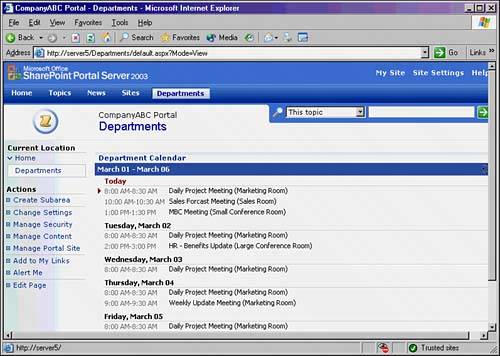Justifying and Deploying Business Portals
| As the cost of providing a portal structure goes down, it makes business sense to create portal-based solutions as opposed to purchasing, installing, and maintaining software on individual PCs for accessing information. Maintaining a web browser on each desk and centralized application structure flexible enough to provide access for any set of users is generally much more cost effective and presents a means for implementing innovative solutions that may have been too costly to deliver using traditional methods. When applications or new features are added to the portal, they are instantly available to users without having to touch every desktop. Delivering information and applications via a web browser also reduces the burden on the IT department while providing it with the necessary control over who has access to the information and applications. Leveraging Various SharePoint Components for a Portal SolutionThe backbone of the business portal is SharePoint Portal Server 2003. It provides the platform for creating an enterprise portal for centrally managing, storing, sharing, and accessing information. When appropriately designed, the portal can be used to quickly find relevant information and provide a means for team collaboration. Users can create their own customized view of the portal to meet their needs, and information can be targeted to the individual based on her role. Team and workgroup collaboration, document management, and list management are accomplished using Windows SharePoint Services. It is more oriented to facilitating information sharing and document collaboration. Its features make it easy for users and teams to work together and enable managers to coordinate content and activities. Microsoft Office 2003, when used in conjunction with Windows SharePoint Services, further enhances user productivity by providing an integrated desktop that accesses server collaboration services using tools that users are familiar with. Leveraging Full Portal Collaboration with Office 2003 TechnologiesMicrosoft Office 2003 provides an interface that users are familiar with and is the primary tool for creating and modifying documents. Elements of Microsoft Office 2003 can also be integrated with SharePoint technologies to provide a central web-based accessibility to information. Deployment of a SharePoint solution can realize maximum benefits through the parallel deployment of Microsoft Office 2003 Technologies. Although other methods of access are supported, the richest support and integration with SharePoint 2003 comes with the Office 2003 component at the client level. In addition to familiar tools such as Excel and Word 2003, Office 2003 adds functionality with tools such as InfoPath 2003, which can be used to maintain an XML forms-based library in SharePoint. Managing Business Processes with BizTalk Server 2002Microsoft BizTalk Server 2002 and custom-developed Web Parts provide the means for integrating line-of-business applications into the portal environment. Microsoft BizTalk Server 2002 includes the tools to integrate applications, whereas Web Parts can be developed for the integration with SharePoint. This provides end users with the ability to perform business transactions and retrieve information from business systems without having to leave the portal or learn new applications. In addition, BizTalk itself centralizes access and control to disparate volumes of corporate data, allowing more intelligent business decisions to be made. Improving Communications and Collaboration with Exchange Server 2003 IntegrationAn effective SharePoint environment encompasses both collaboration and communication concepts into its design. The ability to alert users of document changes, for example, takes advantage of email routing. SharePoint Portal Server 2003 has the capability to interface with any SMTP server to relay messages but can be most effective when used in conjunction with a Microsoft Exchange Server 2003 environment. Integration with Exchange Server 2003 or, to a lesser extent, Exchange 2000, allows for tight integration with the various components of Exchange itself, such as shared calendars, direct access to mailbox items, task lists, and public folders. Alerts can be sent to mail-enabled public folders, for example, to allow them to be viewed by multiple users. A departmental calendar can be set up in Exchange and displayed in SharePoint, to use another example, as shown in Figure 22.6. Figure 22.6. Displaying an Exchange Server 2003 calendar in SharePoint. Leveraging an existing Exchange Server 2003 deployment with SharePoint greatly extends the reach of both applications, filling gaps in functionality for each of the products. The most functional, collaborative environments can be created by a combination of these technologies. NOTE Lesser versions of Exchange, such as Exchange 2000, are supported directly from within SharePoint as Web Parts, although the integration features such as those available with the Exchange Server 2003 version of Outlook Web Access are not as rich. |
EAN: 2147483647
Pages: 288